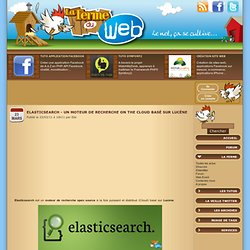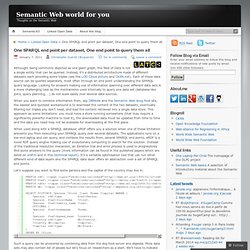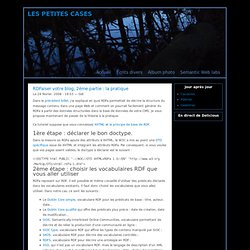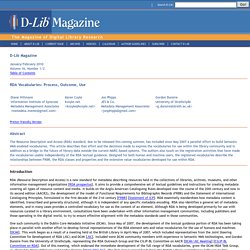

Federated SPARQL query options. Announcing the LATC Data Publication & Consumption Tools Library. A new resource is available for linked data professionals: “In order to support data set owners to publish their datasets as Linked Data on the Web, as well as to support data consumers to access and integrate Linked Data from the Web, the LATC project has compiled a library of open source toolkits that cover all stages of the Linked Data publication (modeling, linking, serving) and consumption process (discovery, consolidation, application).

By gathering high-quality open source tools in the form of a consistent library, we hope to lower the barriers to publishing Linked Data as well as to interacting with the Web of Data.” The announcement continues, “This website presents the initial version of the LATC Data Publication & Consumption Tools Library. The website gives an overview of the main steps of the Linked Data publication and consumption process and associates open source tools from the library to each step in the process.”
Callimachus - Callimachus is a Semantic Web framework for easily building hyperlinked Web applications. ElasticSearch - Un moteur de recherche on the cloud basé sur Lucène. Elasticsearch est un moteur de recherche open source à la fois puissant et distribué (Cloud) basé sur Lucène.

Les objectifs d'elasticsearch sont simples: Obtenir un moteur de recherche: rapide facile à mettre en placeavec un schéma totalement libre (nosql)utilisable avec du JSON over HTTP et on the cloud (entendez par là, solution distribuée sur plusieurs machines). Et les résultats sont là ! Elasticsearch est une solution efficace pour faire de la recherche sur des applications utilisant à la fois des BDD nosql et sur une architecture cloud. Niveau utilisation, c'est simple, à l'aide de méthodes RESTfull, on va PUT et GET les données pour les indexer ou les récupérer / rechercher. Comme nous n'avons pas de notions de schéma comme en SQL, il suffit d'envoyer un JSON au moteur pour qu'il soit automatiquement indexé (Les types sont automatiquement détectés). Exemple d'indexation de contenu: 1.$ curl -XPUT http: 2. 3. 4. Kwaga partners with Viadeo to add professional profiles to its semantic email filter.
Kwaga, which offers a semantic toolkit to help manage email, is partnering with LinkedIn competitor Viadeo to make the social network’s 30m user profiles available within Gmail, with other email services to follow.

Specifically, Viadeo support is being rolled out first for Kwaga Context so that a sender’s Viadeo profile (if available) will be displayed, as well as other contextual information, at the bottom of each email inside of Gmail. Of note, Kwaga Context already supports LinkedIn and Twitter profiles. In addition to pulling in information about the sender from those supported social networks, Kwaga Context also offers a nifty feature that uses semantic technology to remind a user when important emails have been forgotten or to flag up emails that require more attention or a particular call to action.
Kwaga partners with Viadeo to add professional profiles to its semantic email filter. The Semantic Web & THE POWER OF PULL » Introduction. How the pull paradigm and the semantic web combine to help businesses face the challenges of the future.

The Problem On the Web today, we see millions of web sites, each of which presents web pages and documents. These are simply electronic versions of the old paper-based ways of doing things: writing checks, filing taxes, looking at menus, catalog pages, magazines, etc. When you search for something on Google, you get a list of web sites that may or may not have what you’re looking for, based on keywords found in the text. You have to look at each one and decide whether it answers your question. Our information infrastructure isn’t scaling up very well at all.
The solution to our information problem is the semantic web and the pull paradigm. Realtime Social Semantic Web « Laurens goes semantic… SEO, the Semantic Web and Information Discovery. The following is a transcript of a talk presented at a dual meetup of Vancouver Search Engine Marketing Group and the The Vancouver Semantic Web Meetup Group on 6 January 2011.

One SPARQL end point per dataset, One end point to query them all « Semantic Web world for you. Althought being commonly depicted as one giant graph, the Web of Data is not a single entity that can be queried.

Instead, it’s a distributed architecture made of different datasets each providing some triples (see the LOD Cloud picture and CKAN.net). Each of these data source can be queried separately, most often through an end point understanding the SPARQL query language. Web² PR and Web 3.0. SalsaDev - When Information Makes Sense. Web 3.0. RDFaiser votre blog, 2ème partie : la pratique. Dans le précédent billet, j'ai expliqué en quoi RDFa permettait de décrire la structure du message contenu dans une page Web et comment on pourrait facilement générer du RDFa à partir des données structurées dans la base de données de votre CMS.

Je vous propose maintenant de passer de la théorie à la pratique. Ce tutoriel suppose que vous connaissez XHTML et le principe de base de RDF. Dans la mesure où RDFa ajoute des attributs à XHTML, le W3C a mis au point une DTD spécifique issue de XHTML et intégrant les attributs RDFa. Par conséquent, si vous voulez que vos pages soient valides, le doctype à déclarer est le suivant : RDFa reposant sur RDF, il est possible et même conseillé d'utiliser des prédicats déclarés dans les vocabulaires existants. Easy RDF and SPARQL for LAMP systems - ARC RDF Classes for PHP. Les RDA en RDF. RDA Vocabularies: Process, Outcome, Use. D-Lib Magazine January/February 2010 Volume 16, Number 1/2Table of Contents RDA Vocabularies: Process, Outcome, Use Printer-friendly Version Abstract The Resource Description and Access (RDA) standard, due to be released this coming summer, has included since May 2007 a parallel effort to build Semantic Web enabled vocabularies.

Introduction RDA (Resource Description and Access) is a new standard for metadata describing resources held in the collections of libraries, archives, museums, and other information management organizations [RDA prospectus]. One such community is the Dublin Core Metadata Initiative (DCMI). The charter of the Task Group is "to define components of the draft standard 'RDA - Resource Description and Access' as an RDF vocabulary for use in developing a Dublin Core application profile" [RDFS].
The Resource Description Framework (RDF) is a group of specifications developed by the World Wide Web Consortium (W3C) as a model for metadata description. Metadata Standards Notes. Pearltrees, RDF & Perl.